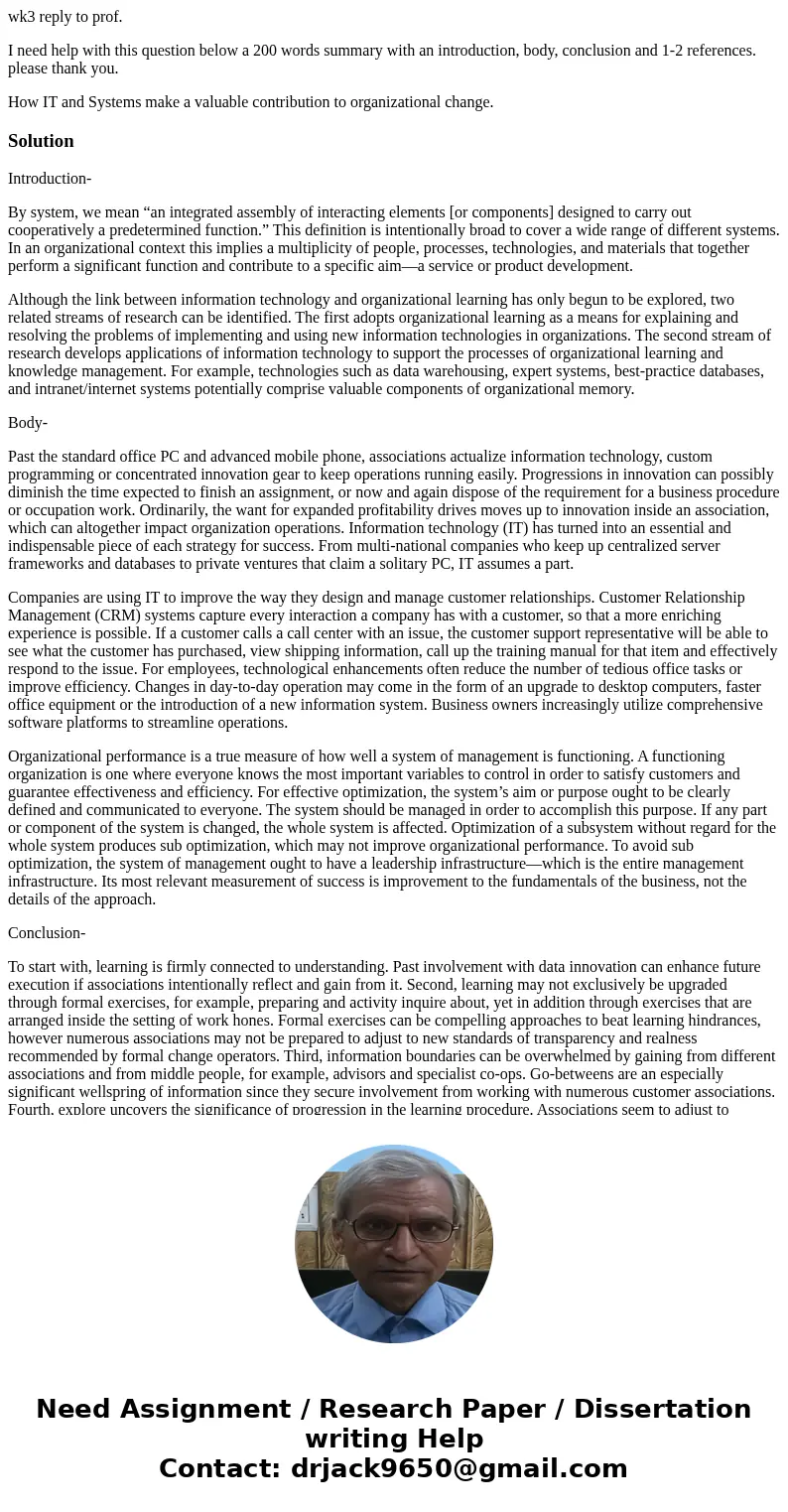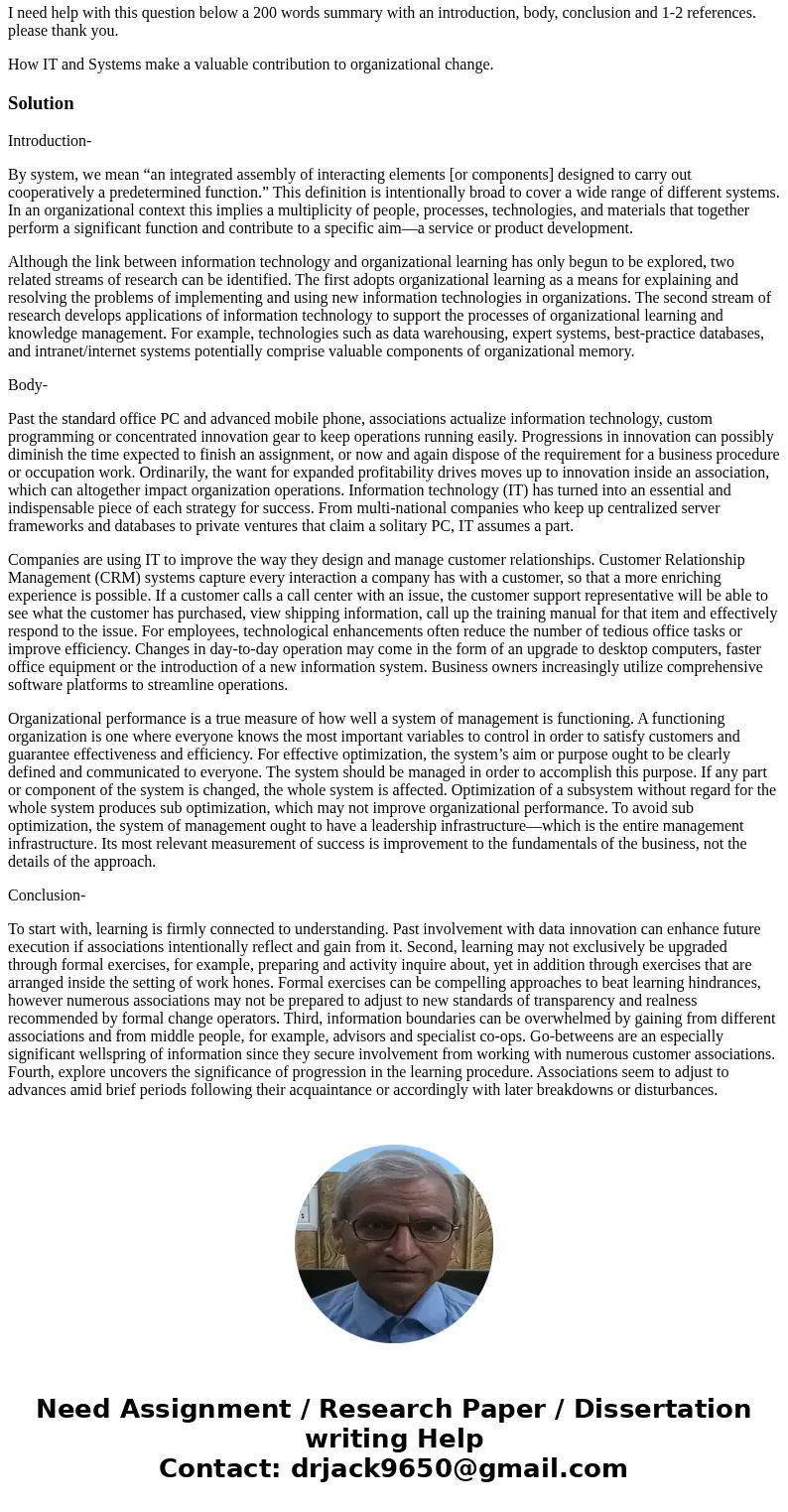wk3 reply to prof I need help with this question below a 200
wk3 reply to prof.
I need help with this question below a 200 words summary with an introduction, body, conclusion and 1-2 references. please thank you.
How IT and Systems make a valuable contribution to organizational change.
Solution
Introduction-
By system, we mean “an integrated assembly of interacting elements [or components] designed to carry out cooperatively a predetermined function.” This definition is intentionally broad to cover a wide range of different systems. In an organizational context this implies a multiplicity of people, processes, technologies, and materials that together perform a significant function and contribute to a specific aim—a service or product development.
Although the link between information technology and organizational learning has only begun to be explored, two related streams of research can be identified. The first adopts organizational learning as a means for explaining and resolving the problems of implementing and using new information technologies in organizations. The second stream of research develops applications of information technology to support the processes of organizational learning and knowledge management. For example, technologies such as data warehousing, expert systems, best-practice databases, and intranet/internet systems potentially comprise valuable components of organizational memory.
Body-
Past the standard office PC and advanced mobile phone, associations actualize information technology, custom programming or concentrated innovation gear to keep operations running easily. Progressions in innovation can possibly diminish the time expected to finish an assignment, or now and again dispose of the requirement for a business procedure or occupation work. Ordinarily, the want for expanded profitability drives moves up to innovation inside an association, which can altogether impact organization operations. Information technology (IT) has turned into an essential and indispensable piece of each strategy for success. From multi-national companies who keep up centralized server frameworks and databases to private ventures that claim a solitary PC, IT assumes a part.
Companies are using IT to improve the way they design and manage customer relationships. Customer Relationship Management (CRM) systems capture every interaction a company has with a customer, so that a more enriching experience is possible. If a customer calls a call center with an issue, the customer support representative will be able to see what the customer has purchased, view shipping information, call up the training manual for that item and effectively respond to the issue. For employees, technological enhancements often reduce the number of tedious office tasks or improve efficiency. Changes in day-to-day operation may come in the form of an upgrade to desktop computers, faster office equipment or the introduction of a new information system. Business owners increasingly utilize comprehensive software platforms to streamline operations.
Organizational performance is a true measure of how well a system of management is functioning. A functioning organization is one where everyone knows the most important variables to control in order to satisfy customers and guarantee effectiveness and efficiency. For effective optimization, the system’s aim or purpose ought to be clearly defined and communicated to everyone. The system should be managed in order to accomplish this purpose. If any part or component of the system is changed, the whole system is affected. Optimization of a subsystem without regard for the whole system produces sub optimization, which may not improve organizational performance. To avoid sub optimization, the system of management ought to have a leadership infrastructure—which is the entire management infrastructure. Its most relevant measurement of success is improvement to the fundamentals of the business, not the details of the approach.
Conclusion-
To start with, learning is firmly connected to understanding. Past involvement with data innovation can enhance future execution if associations intentionally reflect and gain from it. Second, learning may not exclusively be upgraded through formal exercises, for example, preparing and activity inquire about, yet in addition through exercises that are arranged inside the setting of work hones. Formal exercises can be compelling approaches to beat learning hindrances, however numerous associations may not be prepared to adjust to new standards of transparency and realness recommended by formal change operators. Third, information boundaries can be overwhelmed by gaining from different associations and from middle people, for example, advisors and specialist co-ops. Go-betweens are an especially significant wellspring of information since they secure involvement from working with numerous customer associations. Fourth, explore uncovers the significance of progression in the learning procedure. Associations seem to adjust to advances amid brief periods following their acquaintance or accordingly with later breakdowns or disturbances.


 Homework Sourse
Homework Sourse